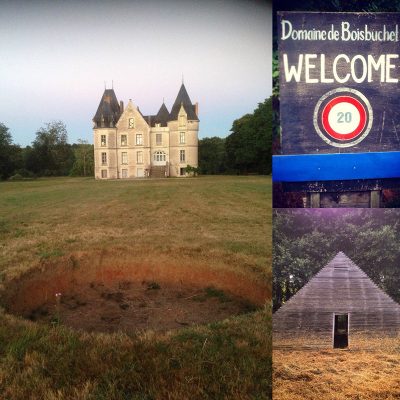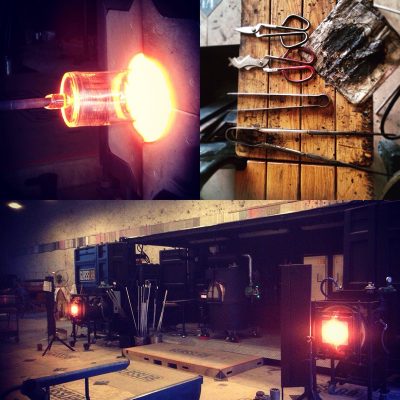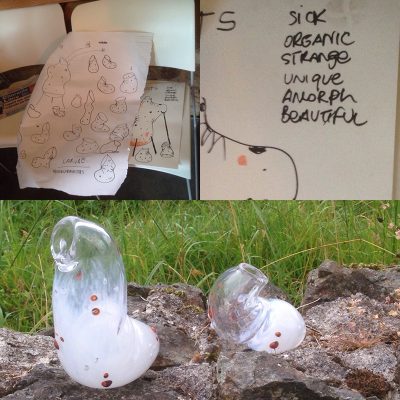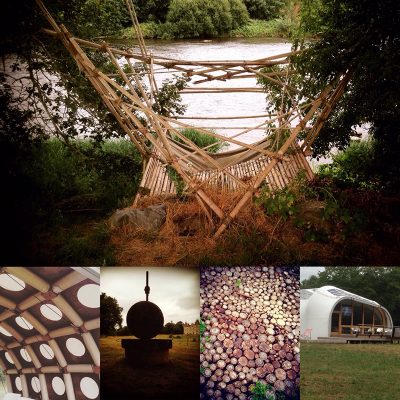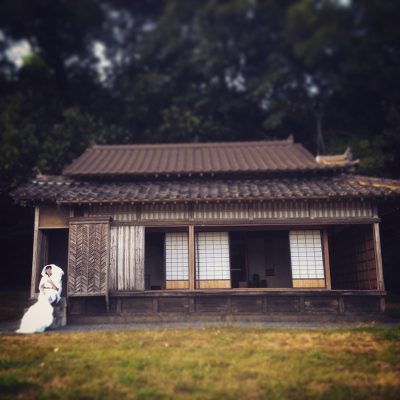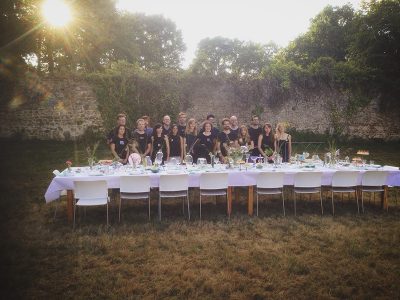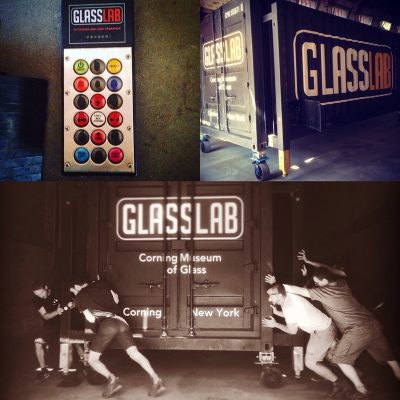Today’s blog author is Laurie Bousquet, a glass artist based in southern France near Montpellier. Having blown glass since 2000 and worked with the Hot Glass team at The Corning Museum of Glass for three years, she currently works at her family’s 150-acre vineyard and winery, Le Clos d’Elle, in the Mediterranean region of Languedoc-Rousillon.
Glass is a technically challenging material to work with; it typically takes many years of study to learn the “rules.” It also requires infrastructure: melting and reheating furnaces firing around the clock at a blistering 2,100° F.
These requirements can be significant barriers to experimentation, spontaneity, and play. In addition, they can create a barrier between the traditional handcraft of glass and the next generation of multi-disciplinary contemporary designers.
The last few weeks, the CMoG GlassLab team has set up temporary base at the world-renowned summer design retreat center, Domaine de Boisbuchet in rural France. The goal? To bridge this gap. The means? A dynamic, experimental, and above all, intensive collaboration with students and designers from around the world.
GlassLab was conceived to allow designers to explore the medium of glass in a way that few have access to. The innovative mobile studio, the first of its kind, packs into a shipping container and can be set up virtually anywhere within a day as long as there’s a propane hookup.
- Domaine de Boisbuchet
- The GlassLab studio, tools, and gloryhole.
Working side by side with our hot glass team — Jeff Mack, Chris Rochelle, Damian François and Laurie Bousquet — workshop participants from various disciplines (including industrial and furniture design, textiles, and product design) were given the rare opportunity to work with molten glass, rapidly prototyping their ideas and learning the language of glass. The goal was not necessarily a finished product, but rather a new and fresh way to approach the material, both conceptually and functionally.
This year, the workshops at Boisbuchet were themed around the idea of “origin and translation.”
Spanish artist and designer Jaime Hayon, founder of Hayon Studio, spent the week working with the hot glass team to realize the students’ concepts in glass and guide them through the thorny process of designing for such a complex, technical material.
Optics, translucency and transparency, function, color and surface decoration, and form were addressed and discussed each day to give the workshop participants the language they needed to approach the material. In addition, the students learned about the process of blowing and shaping glass, including tools, molds, hot torching, stamps and even cold-working processes such as grinding and engraving.
They bumped up against the limits and possibilities inherent to the material, sometimes breaking, and in other cases, sometimes breaking through, experimenting with asymmetrical forms, forms that were open on both ends, and even forms reminiscent of folds of the human body, forms suggestive of ritual and mystery.
- Concept drawing and organic glass forms.
- Goblets and cake platter prototypes; tablecloth hand-drawn by Jaime Hayon.
To structure the workshop, all of the pieces were loosely themed around a feast, and thus included vessels, drinking cups, serving dishes and vases. Pieces ranged from the purely functional to the completely surreal; each told a story of how it was conceived and made.
Our glass team worked 12-hour days in a repurposed stone barn; meals were taken communally at long wooden tables with a view of the 1863 château at the heart of Boisbuchet. Conversation and discussion was never limited to the studio, but spilled over into long evenings over wine by the fire pit, or on walks around the lake, as ideas were roughly scratched out on napkins, and laughter was interspersed with furrowed brows and animated talking and gestures.
Boisbuchet has a history of innovative design and architecture, and the numerous experimental and historical structures that dot the campus — everything from a wooden pyramid themed around the four cardinal directions, an old Japanese tea house, structures entirely built from sustainable materials such as bamboo and paper, and even earthworks — set the scene of the conversations that went late into the night.
- Experimental architecture on the grounds of Boisbuchet.
- The Japanese Tea House
Students signed up for design slots with the glass teams each day. They came to their hour-long sessions with detailed drawings and ideas; some were carefully rendered, some were inspired by nature or the body, and some were simply experiments into the properties and possibilities of glass.
Some sessions simply played with minute changes in proportion and form to communicate lightness or visual heaviness; basic bamboo blow molds were fabricated to play with the ephemeral recording of wood grain and ash on the surface of the glass. Every morning was an exciting moment as we opened the cooling kilns to reveal the previous day’s experiments.
The entire workshop culminated in an incredible shared candlelight meal under the stars, complete with red wine and music.
- Workshop participants with the CMOG team and Jaime Hayon.
- Breaking down and packing up the GlassLab.
At the finish of the workshop, the team broke down the equipment and carefully packed it away inside its shipping container to travel back across the ocean, ready to spark inspiration and innovation for another round of artists and designers.
The students carefully rolled their drawings into tubes and packed away their prototypes in preparation for the next phase of the design process. A new language of working had been introduced, and a rare and privileged glimpse into the process of glass had been presented. Glass is more than a historical material or an industrial process; its transparency and fluidity is perfectly suited as a language for a new generation of cutting-edge designers. In the end, making this connection from the past to the future is what GlassLab and CMoG is all about!
Check out this video summary of the workshop from Boisbuchet:
Jaime Hayon + CMoG | Candy Glass Shop | Boisbuchet 2016 from Domaine de Boisbuchet on Vimeo.


